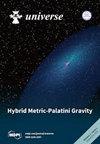热恒星、年轻恒星群和尘埃与 Swift/UVOT
IF 2.5
4区 物理与天体物理
Q2 ASTRONOMY & ASTROPHYSICS
引用次数: 0
摘要
在这篇综述中,我们将重点介绍 Swift/UVOT 仪器在了解星际尘埃的紫外线(UV)衰减和消光特性方面做出的贡献,并深入探讨热恒星和年轻恒星群。这两个领域的研究是相互关联的:只有考虑到前景尘埃的影响,才能了解紫外亮天体,而只有研究紫外亮天体的特性,才能了解前景尘埃。数十年的研究已经证实,尘埃对紫外背景星光的影响是不同的,提出的消光定律有各种各样的斜率,在 2175 Å 处有一个很强的 "凹凸 "光谱特征。我们的研究表明,UVOT 非常适合探测紫外消光定律的变化,特别是因为它的 uvm2 滤光片以凹凸为中心,而且望远镜能够分辨附近的恒星群。当与光学和红外成像结合使用时,紫外可见光望远镜可以对星系与星系之间以及单个星系内部的消光规律变化以及年轻恒星群的特性提供强有力的约束。对 UVOT 的巡天观测包括银河系、本星系群的星系、本地体积遗产巡天(LVLS)和两个深场。所有这些都被用来提供有关紫外尘埃衰减规律及其变化与基本物理过程的联系以及热恒星和年轻恒星群的紫外特性的最详细的信息。本文章由计算机程序翻译,如有差异,请以英文原文为准。
Hot Stars, Young Stellar Populations and Dust with Swift/UVOT
In this review, we highlight the contributions made by the Swift/UVOT instrument to the understanding of the ultraviolet (UV) attenuation and extinction properties of interstellar dust and provide insight into hot stars and young stellar populations. The study of these two fields is interconnected: UV-bright objects can only be understood if the effects of foreground dust are accounted for, but foreground dust can only be accounted for by studying the properties of UV-bright objects. Decades worth of work have established that the effects of dust on background starlight vary in the ultraviolet, with proposed extinction laws having a wide variety of slopes and a strong “bump” spectroscopic feature at 2175 Å. We show that UVOT is uniquely suited to probe variations in the UV extinction law, specifically because of the uvm2 filter that is centered on the bump and the telescope’s ability to resolve nearby stellar populations. When used in combination with optical and infrared imaging, UVOT can provide strong constraints on variations in the extinction law, both from galaxy to galaxy and within individual galaxies, as well as the properties of young stellar populations. Surveys of UVOT have included the Milky Way, the galaxies of the Local Group, the Local Volume Legacy Survey (LVLS) and two deep fields. All of these are being utilized to provide the most detailed information yet about the UV dust attenuation law and the connection of its variation to underlying physical processes as well as the UV properties of hot stars and young stellar populations.
求助全文
通过发布文献求助,成功后即可免费获取论文全文。
去求助
来源期刊

Universe
Physics and Astronomy-General Physics and Astronomy
CiteScore
4.30
自引率
17.20%
发文量
562
审稿时长
24.38 days
期刊介绍:
Universe (ISSN 2218-1997) is an international peer-reviewed open access journal focused on fundamental principles in physics. It publishes reviews, research papers, communications, conference reports and short notes. Our aim is to encourage scientists to publish their research results in as much detail as possible. There is no restriction on the length of the papers.
 求助内容:
求助内容: 应助结果提醒方式:
应助结果提醒方式:


